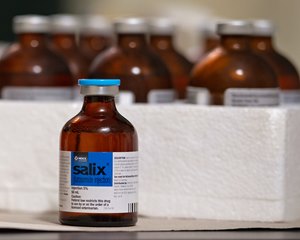Study Finds Promise in Administering Lasix 24 Hours Out


The Grayson-Jockey Club Research Foundation believes a recent published study suggests administering Lasix more than 24 hours out can be effective in preventing exercise-induced pulmonary hemorrhage.
In fact the clinic portion of the study, the second of two recent projects funded by Grayson to examine furosemide (Lasix) administration at 24 hours prior to a race, indicates a low dose of furosemide 24 hours before exercise was more effective than the current standard of four hours before a race.
The study was published in the Journal of Veterinary Internal Medicine.
The project examined fit Thoroughbreds known to be clinical EIPH patients—known bleeders. The research started in a clinic at Washington State University on a treadmill with all horses receiving one of seven different treatments, with the 250 mg dose representing the traditional low dose allowed by regulatory authorities and the 500 mg representing the traditional high dose:
1. Placebo (saline)
2. Conventional (low-dose, 250mg, 5ml) furosemide four hours pre-exercise
3. Controlled water access only with no medication (maintenance water access for 24 hours pre-exercise)
4. Low-dose furosemide (250mg, 5ml) 24 hours pre-exercise with free access to water
5. High-dose furosemide (500mg, 10ml) 24 hours pre-exercise with free access to water
6. Low-dose furosemide (250mg, 5ml) 24 hours pre-exercise with maintenance water access
7. High-dose furosemide (500mg, 10ml) 24 hours pre-exercise with maintenance water access
From all seven of these treatments, the one that was clinically relevant and showed the least amount of blood from horses that suffer from EIPH was treatment No. 6, low-dose furosemide given at 24 hours pre-exercise with maintenance water.
After the clinical trial, the horses returned to the racetrack, trained for one month, and then ran in two simulated 1,100-meter (slightly longer than five furlongs) races at Emerald Downs. The horses received treatment No. 6, the most effective treatment as defined by clinic trial in one race, and a saline control in the other. The races were separated by two weeks of training.
The study concluded there is enough promise in the administration 24 hours out that it should be studied further.
"Administering 0.5 mg/kg furosemide 24 hours pre-racing combined with controlled water intake may be a strategy to replace race-day furosemide administration for the management of EIPH," said the study's conclusion. "A larger study is indicated to further evaluate whether this protocol significantly mitigates EIPH severity"
Grayson said the simulated race results indicate the low-dose furosemide administered at 24 hours prior to post with maintenance water has great promise as a replacement to the current four-hour administration of furosemide for horses who are known bleeders.
"These findings are encouraging and indicate that Lasix is capable of attenuating EIPH for a longer duration than traditionally believed," Grayson said in a release.
To read more about the study visit the National Center for Biotechnology Information.
